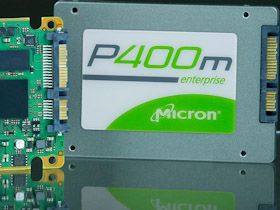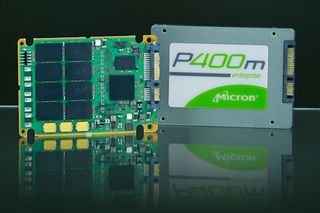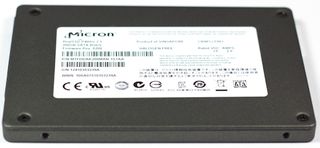Micron P400m SSD Review: High Endurance MLC Is Here To Stay
Endurance. Reliability. Data protection. They're all important factors when it comes time to evaluate high-end storage technology. Micron's P400m, the company's latest enterprise-class SSD, is positioned to not only address those needs, but exceed them.

Micron P400m: Is High-Endurance MLC Here To Stay?
Look back to 2010, just a few short years ago. If you wanted a storage solution that was responsive, reliable, and robust, you probably turned to SLC NAND-based SSDs. They were inordinately expensive, but spending more was justified based on their performance and reliability.
But MLC NAND, which you typically find in desktop-oriented drives, has its own advantages, too. It's cheap, in part thanks to incredibly high production volumes, and it can already be found mated to cutting-edge controller designs. In fact, in 2009, according to Forward Insights, MLC accounted for 90% of the total solid-state capacity shipped. Of course, the trade-off is that MLC must endure high latencies, and can only offer endurance a fraction of what you get from SLC NAND. Even with lots of redundancy and low cost, MLC-based SSDs were just too unreliable for the workloads typical of an enterprise environment.
The industry was at a crossroads. With cloud computing on the rise and a trend toward big data, there quickly came a need for products that combined the benefits of SLC and MLC technologies, while minimizing their drawbacks. Would manufacturers try pulling down the production costs of SLC, or could they somehow make MLC memory behave more like single-level cell NAND?
As implausible as it might seem, the last few months seem to suggest that most companies involved in the enterprise space are choosing the latter path. With drives like Micron's new P400m and Intel's SSD DC S3700 (which we looked at in Intel SSD DC S3700 Review: Benchmarking Consistency), MLC-based offerings are showing up in spaces typically dominated by SLC.

But just as we've seen in the client space, no two enterprise customers are the same. There will always be a place for SLC NAND-based SSDs. Companies like Micron and Intel are instead betting that their affordable MLC-equipped drives can satisfy a majority of situations where pricier SLC-laden drives are currently used out of necessity.
The P400m is the latest addition to Micron's enterprise storage family. It replaces the RealSSD P300, an SLC-based workhorse, finding itself above the low-cost RealSSD P400e, but below the PCI Express-based RealSSD P320h, in Micron's stack.

At launch, the P400m will be available in three capacities: 100, 200, and 400 GB. Expect to pay about $3/GB for the 100 and 200 GB versions, while Micron says the 400 GB version should sell for around $900. These prices are for volume orders, but may change based on demand. The company also plans to sell its P400m family through its distribution channel.
Stay on the Cutting Edge
Join the experts who read Tom's Hardware for the inside track on enthusiast PC tech news — and have for over 25 years. We'll send breaking news and in-depth reviews of CPUs, GPUs, AI, maker hardware and more straight to your inbox.
| Micron P400m | |||
|---|---|---|---|
| User Capacity | 100 GB | 200 GB | 400 GB |
| Interface | 2.5" 6 Gb/s SATA | ||
| Sequential Read | 380 MB/s | ||
| Sequential Write | 200 MB/s | 310 MB/s | |
| 4K Random Read | 52,000 IOPS | 54,000 IOPS | 60,000 IOPS |
| 4K Random Write | 21,000 IOPS | 26,000 IOPS | |
| Power Consumption(Active) | 4 W | 5 W | |
| Power Consumption (Idle) | 0.75 W | ||
| Write Endurance | 1.75 PB | 3.50 PB | 7 PB |
| Encryption | None |
When we first saw the P400m's spec sheet, we were immediately reminded of Intel's SSD DC S3700. They both address a similar customer, include high-endurance MLC memory, ship in similar capacities, and bear comparable pricing. Dig deeper, though, and you'll see that they're actually quite different. Because both products strive to satisfy similar segments, they should really go up against each other.
In that context, the P400m does come out of the gate looking a little underwhelming. Intel's SSD DC S3700, which posts sequential and random reads results of 500 MB/s and 75,000 IOPS across all capacities, respectively, should be able to outperform these numbers. As far as write performance goes, the S3700 takes a commanding lead at 200 GB and higher; the P400m looks like it might lead at the 100 GB capacity point.
Great drives aren't determined by their specifications, though. Lets take a closer look at what makes the P400m tick.
Current page: Micron P400m: Is High-Endurance MLC Here To Stay?
Next Page Inside Micron's P400m SSD-
Nintendo Maniac 64 に?Reply
Seriously though, I wonder why Tom's doesn't run one of their basic "real-world" tests used on consumer SSDs (such as Tom's 7zip test) on one of these professional SSDs just so that we can get an idea how they compare to the consumer-level stuff.
In particular, Tom's always says that comparing one SSD to another is nearly moot point when you consider the magnitude of improvement an SSD has over a traditional HDD; it would be nice to know if these pro-level SSDs are of a similar magnitude of improvement over consumer SSDs or whether the difference is actually less. -
blazorthon Nintendo Maniac 64に?Seriously though, I wonder why Tom's doesn't run one of their basic "real-world" tests used on consumer SSDs (such as Tom's 7zip test) on one of these professional SSDs just so that we can get an idea how they compare to the consumer-level stuff.In particular, Tom's always says that comparing one SSD to another is nearly moot point when you consider the magnitude of improvement an SSD has over a traditional HDD; it would be nice to know if these pro-level SSDs are of a similar magnitude of improvement over consumer SSDs or whether the difference is actually less.Reply
The difference is much, much less in terms of performance difference. Tom's has told us this time and time again. -
mayankleoboy1 Nintendo Maniac 64に?Seriously though, I wonder why Tom's doesn't run one of their basic "real-world" tests used on consumer SSDs (such as Tom's 7zip test) on one of these professional SSDs just so that we can get an idea how they compare to the consumer-level stuff.In particular, Tom's always says that comparing one SSD to another is nearly moot point when you consider the magnitude of improvement an SSD has over a traditional HDD; it would be nice to know if these pro-level SSDs are of a similar magnitude of improvement over consumer SSDs or whether the difference is actually less.Reply
In desktop loads, very very less difference.
In server loads, huge difference. Plus, these server SSD's wil maintain high speeds even after large amounts of data is continuously being written. -
mayankleoboy1 theoretical question : how much life would 100% provisioning give ? So you ship a 512GB MLC drive, but the usable is only 256GB. The rest 256GB is for getting better wrtite endurance.Reply
How would this compare to a true SLC SSD ? -
blazorthon mayankleoboy1theoretical question : how much life would 100% provisioning give ? So you ship a 512GB MLC drive, but the usable is only 256GB. The rest 256GB is for getting better wrtite endurance. How would this compare to a true SLC SSD ?Reply
It'd probably still be inferior overall and not even be cheaper at that point. Over-provisioning is only good for mitigating MLC's disadvantages over SLC AFAIK, not replacing SLC. -
blazorthon mayankleoboy1In desktop loads, very very less difference.In server loads, huge difference. Plus, these server SSD's wil maintain high speeds even after large amounts of data is continuously being written.Reply
Even in server workloads, there are many desktop drives where the performance difference is still not great. For example, Vector is right up there at the tops of the charts with Samsung 840 Pro in performance and many cheaper alternatives are often not far behind in performance. Endurance is another matter, but that wasn't the question. If you want a seriously significant performance difference like with HDDs versus cheap consumer SSDs, you have to consider SSD RAID and/or extreme PCIe storage.
Also, many consumer drives have no trouble keeping performance over time with lots of data written. That's also not an enterprise-only feature. -
drewriley mayankleoboy1theoretical question : how much life would 100% provisioning give ? So you ship a 512GB MLC drive, but the usable is only 256GB. The rest 256GB is for getting better wrtite endurance. How would this compare to a true SLC SSD ?Reply
Some back of the napkin calculations - If you have a consumer 512GB MLC SSD with no over-provisioning, and the MLC was high grade consumer, you could expect 5K P/E cycles. In order to mimic the P400m, which is 35K P/E cycles, the usable space would be ~75GB. By dong that, you would be paying roughly $7/GB for usable storage(assuming you paid $512 for your consumer drive). For SLC, you are looking at 17GB of usable space and $30/GB.
No matter how you look at it, consumer grade MLC will never get close to eMLC and SLC in terms of write endurance, unless the price goes down by orders of magnitude compared to eMLC and SLC. -
drewriley blazorthonEven in server workloads, there are many desktop drives where the performance difference is still not great. For example, Vector is right up there at the tops of the charts with Samsung 840 Pro in performance and many cheaper alternatives are often not far behind in performance. Endurance is another matter, but that wasn't the question. If you want a seriously significant performance difference like with HDDs versus cheap consumer SSDs, you have to consider SSD RAID and/or extreme PCIe storage.Also, many consumer drives have no trouble keeping performance over time with lots of data written. That's also not an enterprise-only feature.Reply
You are correct. Many drives, such as the 840 PRO, would perform great on the enterprise performance tests. There are also a lot of consumer drives that would have problems over time if they aren't allowed to TRIM every so often. We limit the scope of our testing because the main use cases for these drives are enterprise. Will some companies use them in workstations, absolutely. The same can be said for high-end RAID cards too. Nearly every consumer drive would perform very poorly when you take into account write endurance and other enterprise features. -
themdg This technology is moving so fast...hard to keep up. I feel like these articles could use that line from Tommy Boy and get the same point across (to me, at least).Reply
"These hard drives are really cool...you're not even gonna believe it..."
Most Popular

